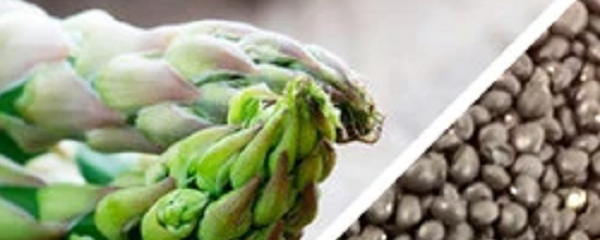

QUICK INFORMATION ABOUT ASPARAGUS
PROPER NAME
Asparagus Officinalis
COMMON NAME
Asparagus
TYPE
Perennial Vegetable
HARDINESS ZONE
4 to 9 (Perennial)
Blooms
Early Spring
MATURE SIZE
1m Tall / 1.6m Wide
SUN EXPOSURE
Full Sun
SOIL TYPE
Loamy & Sandy
SOIL PH
Neutral to Acidic (6.5 to 7.0)
ASPARAGUS
Asparagus is one of the earliest vegetables for harvest in the Spring and one of the few vegetable-grown perennials. It takes years for the plants to mature, so it is advantageous to mark the growing area to remember where it is. A patch will take between three and five years to fill in and mature but are worth the wait. Once matured, you will harvest Asparagus spears for four to six weeks every Spring.
The spears are straight young shoots from the crow with a scaly tip. Late in the season, foliage matures into a light green fern that will change to a golden colour in the fall. You ideally plant from existing crowns in the early Spring.
PLANTING ASPARAGUS
DEPTH
15cm Deep
PLANT/ROW SPACING
30-45cm / 30-45cm
GERMINATION
7-15 Days
DAYS TO MATURITY
3-5 Years
PLANTING SEASON
Spring
Asparagus takes some time, patience and preparation since it takes three years to mature and produce. It’s best to find an out-of-the-way location in your vegetable garden where it will not need to compete with other plants. The plants will require plenty of space and should be kept between 30 and 45cm apart. Asparagus won’t spread much in the first couple of years, but once established will quickly fill in the patch. If planting heirloom varieties, they will need extra space as they are both male and female, will produce seeds and will self-sow. Hybrids will grow only male plants. They won’t make seeds and won’t require as much space, and will only reproduce through the existing crown.
Asparagus can be started from seeds about four weeks before the frost date. Doing this will add several years to the maturing of the plant. Growing your Asparagus from crowns is much easier and is widely available in the Spring. The crown looks like an old mop but is very much alive. Unlike many plants, Asparagus crowns can handle some air exposure, and you can usually find them for sale. Be sure that they are fresh, firm and not withered looking.
Plant crowns in a trench in the Spring, about 30cm deep and wide. Combine the fertilizer, compost and other organic matter to create mounds about 45cm apart. Place your crowns on the piles with the roots spread down the sides. The top of the Asparagus crown should be about 15cm below the soil grade. Cover the crown with soil and water well. When the shoots start to emerge, add more soil to fill the trench until it’s flush with the grade of the surrounding soil.
Remove all weeds before planting, and keep weeding while the plants are young. Roots form a tightly woven mat that makes it difficult to remove weeds without damaging the roots. Add mulch around the bed to assist in controlling the weeds. Be sure not to add any other plants to the Asparagus bed as they dislike competing for nutrients.
PRUNING ASPARAGUS
There isn’t a lot to pruning Asparagus. Trim the ferns over the crown to the ground once they turn golden every fall. Be sure to wait until they’ve turned gold as they help the Asparagus crown grow and prepare to produce next Spring.
CARING FOR ASPARAGUS
LIGHT – Asparagus plants need full sunlight. A lack of sun will result in thin spears and weakened plants, subject to many problems.
SOIL – It’s essential to add amendments and prepare your soil before planting, as Asparagus is a long-living perennial. Be sure to work in lots of Organic Matter and maintain a soil pH of 6.5 to 7.0. Be sure to pull any weeds and large rocks in the area before planting, as the crown doesn’t like to compete for nutrients or space. Always keep your plants on the higher end of the garden and aren’t sitting in excessive moisture.
WATER – Asparagus requires regular watering, especially when it’s young; give it 2.5 to 5cm of water each week for its first couple of growing seasons; give mature, established plants about 2.5cm a week. A good start early on will cause many fewer problems in the future. Drip irrigation or soaker hose is a wise addition to any Asparagus patch.
TEMPERATURE/HUMIDITY – While growing, Asparagus likes temperatures of 21-29C during the day and 15-21C at night. The shoots will begin to form once the soil temperature reaches 10C in the Spring. If you get a frost after the spears arrive, you will see discolouration, and you may see slow growth if temperatures sit outside of 12 to 29C.
FERTILIZER – When Amending Your Soil for the Asparagus, add liberal amounts of Compost, Organic Fertilizer, Rock Phosphate and a natural mineral powder to promote root growth. The key to great Asparagus is a good and strong root system. Keep your soil high quality, and feed the plants with nutrient-rich compost annually. Do this in the early Spring or the late Fall after pruning the fronds. Heavy feeders like Asparagus also benefit from a dose of Organic Fertilizer in mid-Spring when the plant is actively growing.
VARIETIES OF ASPARAGUS
Newer Cultivars are all bred to be male as they can then put all their energy into growth and not setting seeds.
PRINCEVILLE
Princeville does the best in warmer climates.
PURPLE PASSION
Purple Passion is a sweet and juicy purple variety.
BROCK IMPERIAL
Brock Imperial is desired for its high yields.
MARY WASHINGTON
Mary Washington is the most common variety with Rust resistance.
JERSEY GIANT
Jersey Giant; produces yields early and is resistant to Fusarium Wilt and Rust.
Green and White Asparagus are the same plants. Using the process of blanching, which deprives the green spears of light, they can’t photosynthesize and create fibres. Cover the growing spears with something that restricts the light. The spears then turn smooth, white and fibre-free as long as you keep them chilled to prevent the fibre from forming.
HARVSTING ASPARAGUS
Do NOT harvest your asparagus spears until the third year after planting. They require this time for the crown to establish and build up root strength. It is crucial for the first year when the shoots form. Remember, the plants need patience if they’re going to survive.
You can start to harvest a few spears in the third year, but the plant still isn’t fully mature, so don’t harvest for more than a couple of weeks before letting the rest of the spears grow undisturbed. Allowing the fronds to form will create airy foliage that will help feed the plant.
In year four, you can harvest spears when they reach 12-17cm long (any diameter) before the tips start to separate into fronds. Snap or cut the spear off just above the soil line. Take care not to damage any other chutes while trimming your spoils. Try to keep the harvest to a maximum of three weeks.
In years five and beyond, harvest for four to six weeks. The spears should continue to emerge from the soil through the Spring, but when the weather warms up, the spears start getting spindly, which means it’s time to let them go to seed. Following this recipe, your plants can produce for 20+ years and maybe divided or transplanted if you wish to move or start another patch.
WINTERING ASPARAGUS
Be sure to cut every stalk to the ground each year before new growth starts. Do this in the Fall or Winter after everything has died. Early removal keeps Asparagus Beetles from wintering in your stalks. Although leaving the debris can hold snow, which protects the crowns from freezing temperatures. Either way, remove the dead stalks in the Spring before the new growth starts.
PESTS & DISEASES AFFECTING ASPARAGUS
Asparagus is a very robust plant and doesn’t have many problems. Fusarium Wilt and Rust can cause issues in older cultivars. You can avoid them by planting hybrid cultivars.
The Asparagus Bettle is the worst pest for Asparagus growers. Watch for them on the spears as they emerge in the Spring. They’re most active in the afternoon and can be handpicked or doused in Neem Oil to keep them under control.
Education, Tutorials, Planning & More…
Click Here to Return to the Main Page


